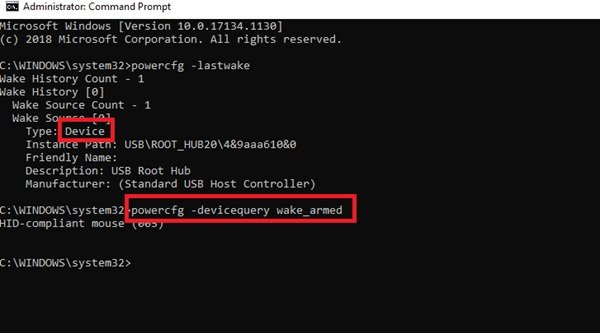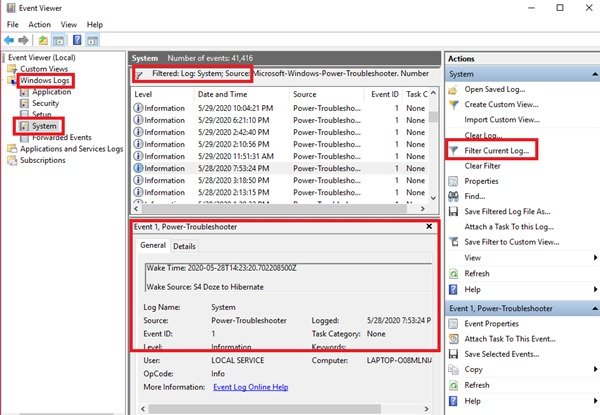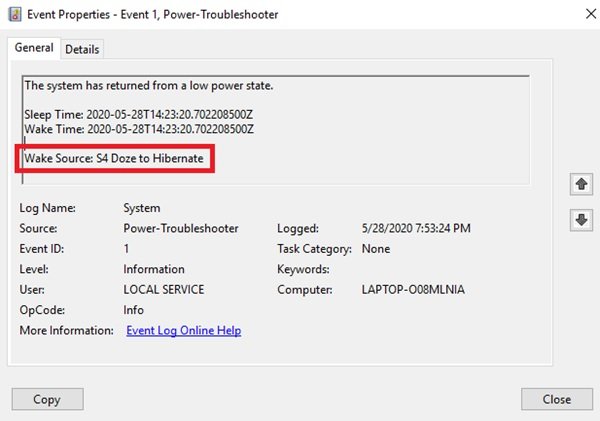Windows Sleep mode settings
Windows 11/10 ‘Sleep’ mode helps in conserving energy by putting the PC into a low-power state and turning off the display when it is not in use. Unlike a total shutdown or reboot, Sleep mode helps the user resume work much faster and pick up exactly from where he/she left it – including any application, documents, and folders that were opened. Windows also puts the computer system into sleep mode automatically. Automatic sleep settings allow the user to choose when exactly they want their computer to sleep and when it should automatically wake up. Explaining in simpler terms, when a PC is put to sleep it enters a state where most of its components are shut off instead of its memory. This lets the user quickly wake the computer back to the same state it was when it went to sleep.
What could be the wake source of Windows 10 PC?
There are different types of unpleasant reasons behind the wake source of Windows 10 PC: Above stated were just a few reasons that could be interfering in your PC’s sleep, catching the actual troublemaker is crucial here. Read: Computer automatically waking up from Sleep.
Why did my Windows PC wake up automatically?
Here is how you can find out why your system unexpectedly wakes up after going to sleep:
1] Single command line diagnosis
This solution demands the use of Command Prompt, as Windows does not reveal this information in any graphical interface. Follow these steps: 1] Launch the ‘Command Prompt’ as an administrator. Search for ‘cmd’ in the ‘Start menu’, right-click on the program, and hit ‘Run as administrator’. 2] Now, type the command ‘powercfg -lastwake’ and press the Enter key.
Please note – The output of the command will vary depending on the type of event that woke up the system. In the screenshot below, you can see that the problem can be attributed to a USB hardware device.
Other sources may also be seen as network activity or a scheduled wake timer. Below mentioned are other command lines to spot the wake source of Windows 10 PC. Device query command: Wake times query command: Done, this information should help you to detect the causes of any unexpected wakeups. Read: Windows computer turns on by itself.
2] Windows Event Viewer
Like the first solution, this one also demands the use of Command Prompt to open the Windows Event Viewer, follow these steps: 1] Launch the ‘Command Prompt’ as an administrator. Type ‘cmd’ in the ‘Start menu’, right-click on the program, and hit ‘Run as administrator’. 2] Now type, ‘eventvwr.ms’ in the command prompt line to open the ‘Windows Event Viewer’. 3] In the Windows Event Viewer, select ‘Windows Logs > System’ in the left-sidebar. 4] When you see the log displayed, click on ‘Filter Current Log’ on the ‘Actions’ menu appearing in the right-sidebar.
5] This opens a new window that allows the user to customize what is displayed in the selected event log. 6] In the ‘Filter Current Log’ window, locate ‘Event sources’ and select the ‘Power-Troubleshooter’ option from the context menu.
You will now see all the entries listed by level, date & time, and event IDs. You can open individual entries to check the wake source of Windows PC.
Difficulties with sudden sleep resumes are very common on Windows devices, we hope this guide helps you know what precisely is causing the problem – indeed this will make fixing the issue much easier. Do let us know if you have any further queries in the comments section below, we will be happy to address it. Read next: How to prevent the computer from waking up from Sleep?




